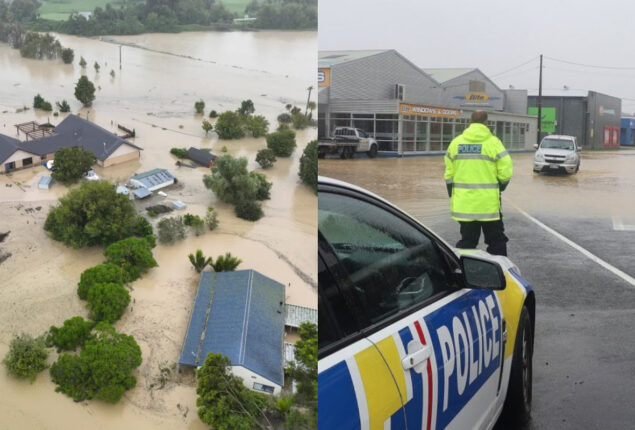Thousands left without power as Cyclone Gabrielle lashes New Zealand
Authorities have issued severe weather warnings. New Zealand is considering imposing a...

New Zealand announces a national state of emergency due to Cyclone Gabrielle
The destruction caused by Cyclone Gabrielle, according to the prime minister of New Zealand, is unlike anything that has happened “in a generation.”
The Chris Hipkins administration has only ever proclaimed one state of emergency in New Zealand’s history.
The afflicted areas are home to five million people, or almost a third of the total population.
Many individuals have had to leave their houses because rivers have overflowed their banks, and some have had to swim to safety.
Numerous individuals have been rescued from rooftops. About 25,000 people lack electricity. Falling trees have demolished homes, and landslides have swept away others and blocked roads.
The devastation caused by the storm has been most severe in coastal villages along the extreme north and east coast of the North Island, with areas like Hawke’s Bay, Coromandel, and Northland among the most affected.
Communications to one village in the area were completely cut off after a river burst its banks.
The civil defense apparatus in Hawke’s Bay, according to authorities, was unable to handle the scale of the destruction. Assistance has been pledged by both Australia and the UK.
After getting trapped in a landslide at Muriwai, west of Auckland, a firefighter is still unaccounted for. Rescue organizations claim that a second firefighter involved was seriously harmed.
According to Marcelle Smith, who spoke to the BBC, she and her two young children fled inland on Monday night. On the east coast of the North Island near Parua Bay, Marcelle Smith and her family live in a house that is perched on a cliff.
Her partner remained to provide security for their home. They continued to deal with unexpected weather on Tuesday, and numerous embankments that had been built had already been carried away.
“We are doing everything we can to protect the things we have dedicated our entire lives to. At the moment, it’s man versus nature.” She revealed the news.
Some Hawke’s Bay homeowners reportedly had to swim out of their flooded homes by scaling bedroom windows, according to local media. The possibility of a prolonged power outage has been cautioned to the public.
Aerial photographs of the flooded areas showed people standing on roofs, waiting for assistance.
A few illustrations of the tremendous breadth of the damage include uprooted trees, bent street lights and poles, and unending rows of flooded dwellings.
The New Zealand Defense Force posted dramatic pictures of rescuers hauling in a stranded sailor whose yacht was swept out to sea after its anchor line snapped in strong winds.
The amount and destruction that we are witnessing, according to Mr. Hipkins, “have not been seen in a generation.”
“As the cyclone intensifies, we are still forming an understanding of its implications. The influence, however, is undeniably significant and extensive.”
He has pledged to give the disaster’s victims NZ$11.5 million (£6 million; US$7.3 million) in aid.
On Tuesday morning, Kieran McAnulty, the minister for emergency management, announced a national state of emergency and described the storm as “unprecedented.”
The emergency order allows the administration to respond to the problem more quickly. It has been used in Northland, Auckland, Tairawhiti, Tararua, Bay of Plenty, Waikato, and Hawke’s Bay.
Only twice before, during the Covid-19 pandemic and after the 2011 Christchurch earthquake, has New Zealand declared a state of emergency.
The administration has connected climate change to the size of the calamity.
The severity of it, of course, [is] made worse by the fact that our global temperatures have already increased by 1.1 degrees, according to climate change minister James Shaw.
“We must stop giving reasons for why we are not acting. We can’t bury our heads in the sand while the beach is inundated. The time to act is right now.”
Cyclone Gabrielle made landfall in New Zealand just two weeks after the area was devastated by heavy rain and flooding that killed four people.
The MetService predicts that the situation will improve over the following few days, and heavy rain alerts are being lifted for a number of areas around the country. It has, however, issued a warning that wind can possibly cause more damage.
Catch all the International News, World News, Breaking News Event and Latest News Updates on The BOL News
Download The BOL News App to get the Daily News Update & Follow us on Google News.